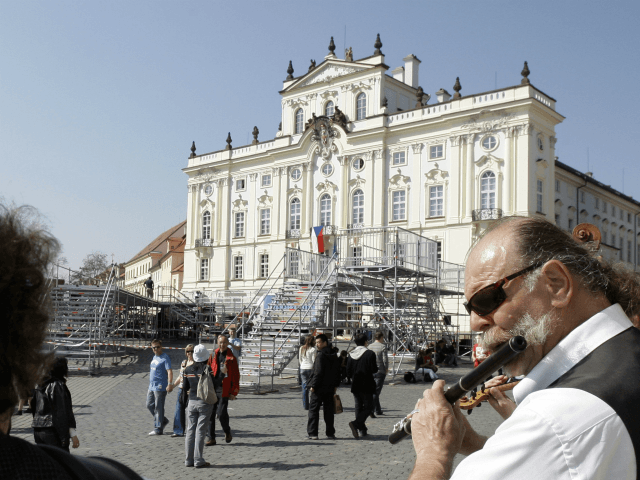PRAGUE (AFP) – On a fine spring day in the Czech capital, a young busker draws a crowd with his rendition of “Knockin’ on Heaven’s Door”. Little does he realise the poignancy of the Bob Dylan lyrics.
Since the pedestrian zone where he’s standing was built in 1985 in the heart of Prague, thousands of people unknowingly walk daily across a pavement made of tombstones taken from a derelict Jewish cemetery.
The sturdy, blue-grey hued slabs that line Wenceslas Square, distinct from the finer cubic stones typical elsewhere in Prague, are a legacy of the Communist past, but no less distressing for the Jewish community.
“Some things are always shocking, regardless of your faith,” says Leo Pavlat, head of the Jewish Museum in Prague.
“Does this barbarian act offend only Jews, or is it a matter of culture, decency, shared citizenship?”
Pavlat told AFP that he had kept two of the paving stones, which he had taken off a pile at the time of the pavement’s construction, as a “sad reminder”.
“They had an inscription in Hebrew,” he added.
Since the 1989 fall of Communism, Jewish representatives have taken up the issue of the paving stones — and the upset they cause — with authorities several times.
But to no avail, they said.
– ‘Long, rich history’ –
“We talked about it with several interior ministers and mayors of Prague.
“They were sympathetic but things became complicated lower down, when civil servants raised different obstacles of a technical and organisational nature,” said Tomas Kraus, secretary of the Czech Federation of Jewish Communities, which has about 3,000 members.
With great pomp, Czechoslovakia’s totalitarian regime opened the pedestrian area in November 1985.
Surrounded by dozens of revamped historic buildings, it soon became popular, connecting Wenceslas Square with the Royal Mile that takes millions of tourists annually from downtown to the castle that overlooks Prague.
For decades the Jewish paving stones’ fate has upset some residents, without ever becoming the subject of a wider public debate.
“I didn’t know (the paving was formerly Jewish tombstones), and to tell the truth, it’s all the same to me. I have other worries,” Karel Cihak, a manager in his 50s, told AFP.
His friend, Jaroslav Trnka, thinks differently.
“I’m hearing that for the first time too. But that seems scandalous to me. The Jewish community here has a long and rich history, inseparable from that of Prague,” he said.
Tourists seem just as surprised.
“Really? We’re walking on tombstones here? Very strange,” says Fabio Marangoni, a young Italian told AFP, munching on a Wenceslas sausage near the paved area.
– ‘Magnificent work’ –
At its unveiling, the Communist daily Rude Pravo called the pedestrian zone “a magnificent work of socialist construction”.
“This is a symbol adequate to the greatness of our time,” then-president and Communist Party chief Gustav Husak said.
But he did not mention that the stones came from a neglected Jewish cemetery in the northwestern village of Udlice, nor that they were placed with the Hebrew inscription facedown.
“For the Communist regime, Jews were the arch-enemy,” said Kraus.
“The authorities wanted to get rid of all things Jewish,” he told AFP.
He attributed this hatred, in part, to Soviet dictator Joseph Stalin’s failed dream of seeing modern Israel transformed into a regional island of Communism and ally of the Soviet Union after independence in 1948.
The Israeli communists only managed to win a small share of the vote in elections the following year and a wave of latent anti-Semitism swept across the Soviet Union and its Communist satellites, who viewed Israel as an imperialist state.
– Anti-Semitic propaganda –
“Communist propaganda remained very anti-Semitic and anti-Israel until the regime was toppled,” said Kraus.
Between the two World Wars, the Jewish population on the territory of today’s Czech Republic numbered around 120,000 people, of whom 80,000 died during the Nazi occupation.
By the time of the Soviet-led invasion of Czechoslovakia in 1968, the Jewish community was around 16,000. Half of them left out of fear of further persecution.
Cemeteries and synagogues have gradually fallen into oblivion.
There are no current official figures but the Jewish community is estimated to number up to 4,000 now.
– ‘Repair long overdue’ –
The pedestrian zone in central Prague is bustling all year long, with seasonal markets at Easter and Christmas, shows by amateur artists, sports events and protest rallies.
A recent article in the Dnes daily again raised the Jewish stones issue. “That ought to have been repaired a long time ago,” its author, journalist Ondrej Hanko, told AFP.
City officials insist they are conscious of the need to act.
“This paving should be changed out of respect for our ancestors,” said the councillor in charge of culture, Jan Wolf, who added he wanted to meet Jewish community representatives soon.
Prague Mayor Adriana Krnacova said she plans to do the same.
“In any case, it’s good to talk about it so that people know. It will serve as a reminder,” said Kraus.

COMMENTS
Please let us know if you're having issues with commenting.